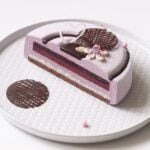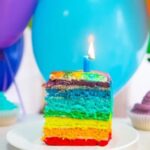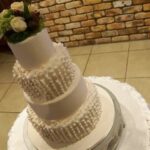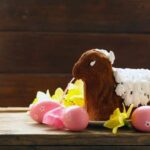Buttercream cake decorating is a popular and versatile technique that allows bakers to create beautiful and delectable cakes. This method involves using buttercream frosting to pipe, smooth, and create various designs on a cake. With just a few essential tools and ingredients, anyone can learn how to decorate cakes like a professional.
The concept of buttercream cake decorating is simple yet yields impressive results. Buttercream frosting is made by combining butter, sugar, and flavorings such as vanilla extract or cocoa powder. The smooth and creamy texture of the frosting makes it perfect for piping intricate designs or creating smooth finishes on cakes.
One of the reasons why buttercream cake decorating has gained so much popularity is its versatility. Whether you want to create elegant wedding cakes, whimsical birthday cakes, or festive holiday treats, buttercream can be used to achieve a wide range of designs and styles. Its pliability allows for intricate details like rosettes and ruffles, while its malleability makes it easy to achieve a flawlessly smooth surface.
In this article, we will explore the world of buttercream cake decorating in depth. We will discuss the essential tools and ingredients needed for this technique, provide step-by-step instructions for beginners, showcase different techniques with visual examples, offer tips and tricks from expert decorators, share flavor variations and enhancements for the frosting, address common questions and troubleshooting issues, and highlight how buttercream cake decorating can be used for special occasions.
By the end of this article, you will be inspired to unleash your creativity and discover the joy of buttercream cake decorating.
Essential Tools and Ingredients for Buttercream Cake Decorating
Buttercream cakes are a delicious and beautiful treat that can be enjoyed for any occasion. Whether you’re a professional baker or just starting out, having the right tools and ingredients is essential for successful buttercream cake decorating. In this section, we will discuss the key tools and ingredients needed to create stunning buttercream cake designs.
Tools:
- Offset Spatula: This tool is used to evenly spread and smooth the buttercream on the cake’s surface.
- Piping Bags: Piping bags are essential for creating intricate designs and patterns on your cake. They come in various sizes and can be fitted with different piping tips to create different effects.
- Piping Tips: Piping tips determine the shape and size of the icing as it is applied to the cake. There are a wide variety of tips available, each creating a unique design.
- Turntable: A turntable allows you to easily rotate your cake while decorating, ensuring even coverage and easier access to all sides of the cake.
Ingredients:
- Butter: Butter is the main ingredient in buttercream frosting, giving it its creamy texture and rich flavor.
- Confectioners’ Sugar: Also known as powdered sugar, confectioners’ sugar is used to sweeten and thicken the buttercream frosting.
- Vanilla Extract: Vanilla extract adds flavor to the buttercream frosting. You can also experiment with other extracts like almond or lemon to create different flavor variations.
- Food Coloring: Food coloring allows you to add color to your buttercream frosting, making it easy to customize your cakes for any theme or occasion.
By having these essential tools and ingredients on hand, you’ll be well-equipped to start creating beautiful buttercream cake designs.
Step-by-Step Guide to Buttercream Cake Decorating
Buttercream cake decorating is a popular and versatile technique that allows for endless possibilities when it comes to designing and creating beautiful cakes. Whether you’re a beginner or an experienced baker, this step-by-step guide will help you navigate the process of buttercream cake decorating with ease.
Step 1: Prepare Your Cake
Before you can begin decorating, it’s important to start with a well-prepared cake. Make sure your cake layers are level and cooled completely before moving on to the next step. You may also want to consider trimming off any domed tops to ensure a flat surface for decorating.
Step 2: Crumb Coat
To ensure a smooth and professional-looking finish, apply a crumb coat of buttercream to your cake. This thin layer of frosting acts as a base, sealing in any loose crumbs and providing a smooth surface for your final coat of buttercream. Use an offset spatula to apply the crumb coat evenly, making sure to cover the entire cake.
Step 3: Apply Final Coat of Buttercream
Once your crumb coat has set (about 15 minutes in the refrigerator), it’s time to apply your final coat of buttercream. Start by adding a generous amount of frosting to the top of your cake, then use an offset spatula or bench scraper to spread it evenly across the top and sides. Work slowly and carefully, smoothing out any imperfections as you go.
Step 4: Decorate
Now that your cake is covered in buttercream, it’s time to let your creativity shine. There are countless ways to decorate with buttercream, from piping intricate designs to creating smooth finishes or adding decorative elements like rosettes or ruffles. Choose the techniques that best suit your design vision and have fun experimenting.
Step 5: Finishing Touches
To add extra flair to your decorated cake, consider adding some finishing touches. This could include edible decorations like sprinkles, fondant accents, fresh flowers, or even a personalized message written in buttercream. Let your imagination run wild and make your cake truly unique.
Buttercream cake decorating is an art form that anyone can master with a little practice and patience. By following this step-by-step guide, you’ll be able to create stunning cakes that are not only delicious but also visually impressive. So why not give it a try and discover the joy of buttercream cake decorating for yourself?
Different Techniques for Buttercream Cake Decorating
Buttercream cake decorating offers a wide range of techniques that can transform any plain cake into a work of art. Whether you’re a beginner or an experienced baker, mastering these techniques will take your cake decorating skills to the next level. Here are some different techniques used in buttercream cake decorating:
- Piping: This technique involves using a piping bag fitted with various tips to create intricate designs on the cake. Popular piping designs include borders, flowers, and intricate patterns. The key to successful piping is having steady hands and practicing consistent pressure for even lines.
- Smoothing: Smoothing the icing on the cake’s surface is essential for achieving a polished and professional finish. To smooth buttercream, use an offset spatula or bench scraper to gently swipe across the icing, working from the top to the sides of the cake.
- Ruffles: Ruffles add an elegant and whimsical touch to cakes. To create ruffles with buttercream, use a petal tip in your piping bag and pipe small vertical lines onto the cake, slightly overlapping each line. Gently press down on each line with a fondant smoother to fan out the ruffles.
- Rosettes: These delicate floral designs are perfect for adding beauty to cakes. Using a star tip in your piping bag, start from the center of the desired rosette and pipe in a circular motion until you reach the desired size.
Remember that practice makes perfect when it comes to mastering these techniques. Start with simple designs and gradually work your way up to more complex patterns. Don’t be afraid to experiment with different tips, colors, and combinations to create unique designs that showcase your personal style and creativity.
For visual examples of these techniques, check out online tutorials or watch video demonstrations by expert bakers. Seeing these techniques in action can provide helpful guidance as you practice and refine your skills.
Continue reading this article for more inspiration and ideas on how to make the most of buttercream cake decorating.
Buttercream Cake Decorating Ideas and Inspirations
Buttercream cake decorating offers endless possibilities for creating beautiful and delicious cakes. Whether you are a beginner or an experienced cake decorator, there are countless ideas and inspirations to explore with buttercream frosting. Here are some creative cake designs that can be achieved with buttercream decorating:
- Floral Fantasy: Flowers are a classic choice when it comes to cake decorating, and buttercream is perfect for creating intricate floral designs. From delicate roses to vibrant sunflowers, the options are limitless. Use a variety of piping tips to achieve different flower shapes and sizes, and don’t be afraid to mix colors for a stunning effect.
- Whimsical Designs: Buttercream allows you to let your imagination soar and create whimsical cake designs that will surely delight both kids and adults. Think unicorns, mermaids, or even fairy tale castles. Use different piping techniques to add depth and texture, and get creative with colorful sprinkles or edible decorations.
- Geometric Patterns: If clean lines and modern aesthetics are more your style, buttercream is still the perfect medium for creating geometric patterns on cakes. Achieve sharp edges using an offset spatula or bench scraper, and experiment with different piping tips to create geometric shapes like squares, triangles, or even chevron patterns.
To bring these ideas to life, begin by preparing a smooth base layer of buttercream frosting on your cake using an offset spatula or a bench scraper. Then, use various piping bags fitted with different tips to add details and decorations onto the cake surface. Don’t be afraid to mix colors or layer different shades of frosting for added dimension.
Remember that practice makes perfect when it comes to buttercream cake decorating. Don’t be discouraged if your first attempts don’t turn out exactly as planned – keep experimenting with different techniques and designs until you find what works best for you. With time and patience, you’ll be able to create impressive buttercream cake designs that are sure to wow your family and friends.
Tips and Tricks for Perfect Buttercream Cake Decorating
Buttercream cake decorating can be a fun and rewarding experience, but it also requires some skill and finesse to achieve the desired results. To help you on your journey to creating beautifully decorated cakes, here are some tips and tricks to consider.
- Start with the Right Consistency: The consistency of your buttercream frosting is crucial when it comes to cake decorating. If the frosting is too soft, it will not hold its shape, while if it is too stiff, it will be difficult to work with.
Aim for a medium consistency that allows you to pipe and spread smoothly. If needed, adjust the consistency by adding more powdered sugar for stiffness or a small amount of milk or cream for softness. - Use a Crumb Coat: Before applying a final layer of frosting, it’s important to apply a crumb coat. This thin layer of frosting helps seal in any crumbs and create a smooth surface for your final decoration. Spread a thin layer of buttercream over the entire cake and let it set before proceeding with your decorative design.
- Master Piping Techniques: Piping is one of the most popular techniques in buttercream cake decorating and can create stunning designs. To ensure success with piping, hold the piping bag at a 45-degree angle and apply consistent pressure while squeezing out the frosting. Practice different types of piping tips such as round tips for borders and lettering or star tips for flowers and rosettes.
- Embrace Texture: Buttercream offers endless possibilities when it comes to creating texture on your cakes. Experiment with different techniques such as using an offset spatula to create smooth lines or using a fork to create interesting patterns. You can also try using stencils or textured mats for more intricate designs.
- Get Creative with Colors: Don’t be afraid to play around with colors when decorating your cakes. You can achieve beautiful shades by adding gel food coloring to your buttercream frosting. Mix and match colors to create unique gradients or use different shades for piping and filling.
- Chill and Firm: If you find that your buttercream is too soft or melting, place the cake in the refrigerator for a few minutes to firm up the frosting. This will make it easier to work with and ensure that your designs hold their shape.
Flavor Variations and Enhancements for Buttercream Cake Decorating
One of the many aspects that makes buttercream cake decorating so appealing is the ability to experiment with different flavors and enhancements. By incorporating unique flavors and fillings into the buttercream frosting, you can create a truly delicious and personalized cake. In this section, we will explore some flavor variations and enhancements that can take your buttercream cake decorating to the next level.
Flavored Buttercream Variations
When it comes to flavored buttercream, the possibilities are endless. One popular variation is chocolate buttercream, which adds a rich and indulgent twist to your cake. Simply add cocoa powder or melted chocolate to your buttercream frosting recipe and mix until well combined. You can also experiment with other flavors such as strawberry, lemon, or even coffee by incorporating extracts or fruit purees.
Another delicious option is incorporating extracts like vanilla, almond, or peppermint into your buttercream. These extracts not only enhance the flavor but also add a delightful aroma to your cake. Remember that a little extract goes a long way, so start small and gradually increase until you achieve the desired taste.
Filling Enhancements
In addition to flavored buttercreams, another way to elevate your cakes is by adding complementary fillings between layers. For example, a layer of fresh fruit preserves or lemon curd can provide a burst of tanginess that balances out the sweetness of the buttercream frosting. Other options include chocolate ganache for added richness or even caramel sauce for an indulgent touch.
Experimenting with different combinations of flavors and fillings allows you to create unique cakes that cater to individual preferences. Don’t be afraid to get creative and try unconventional flavor pairings – who knows, you might discover a winning combination.
Whether it’s through flavored buttercreams or enhanced fillings, adding unique flavors and enhancements can truly transform your buttercream cake decorating creations into show-stopping treats that will leave a lasting impression on everyone who tastes them. So grab your mixing bowls, gather your ingredients, and let your imagination run wild as you explore the wide world of flavor variations and enhancements in buttercream cake decorating.
Frequently Asked Questions and Troubleshooting Common Issues
Common Questions about Buttercream Cake Decorating
Buttercream cake decorating can be an intricate and artistic process, and beginners may have a lot of questions. Here are some commonly asked questions about buttercream cake decorating:
- “Can I use regular butter for making buttercream frosting?”
- “How do I achieve smooth and even buttercream on my cake?”
- “What piping tips are best for beginners?”
Yes, you can use regular unsalted butter for making buttercream frosting. It is important to use unsalted butter so that you have control over the saltiness of the frosting. Make sure the butter is softened at room temperature before mixing it with other ingredients.
To achieve a smooth and even finish on your cake, start by crumb coating the cake with a thin layer of buttercream before applying the final layer. Use an offset spatula or bench scraper to smooth out the frosting, holding it at a 45-degree angle to the cake while rotating it.
For beginners, it’s recommended to start with basic round piping tips (such as #1, #2, or #3) to create outlines or simple decorations. These tips are easy to handle and can be used for writing messages or creating small details.
Troubleshooting Common Buttercream Cake Decorating Issues
While buttercream cake decorating is a fun activity, there may be some common issues that arise during the process. Here are a few troubleshooting tips for dealing with these issues:
- “My buttercream frosting is too runny.”
- “Why does my cake bulge after adding the filling?”
- “How do I fix air bubbles or streaks in my buttercream frosting?”
If your buttercream frosting turns out too runny, try refrigerating it for about 30 minutes to firm up before using it. Alternatively, you can add more powdered sugar gradually until you reach your desired consistency.
A common issue when filling cakes is that they may bulge or ooze out the filling. To prevent this, create a dam of buttercream around the edges of each cake layer before adding the filling. This will act as a barrier and keep the filling in place.
To fix air bubbles or streaks in your buttercream frosting, use a paddle attachment on low speed to beat the frosting for a few minutes. This will help break down any air pockets and give you a smoother consistency.
By addressing these frequently asked questions and providing troubleshooting tips, beginners can feel more confident when attempting buttercream cake decorating. Remember that practice makes perfect, so don’t be afraid to experiment and explore different techniques.
Buttercream Cake Decorating for Special Occasions
Buttercream cake decorating is not just reserved for everyday desserts; it is also a wonderful technique to elevate special occasions such as birthdays, weddings, and holidays. Whether you are planning a grand celebration or an intimate gathering, buttercream cake decorating can add a personal touch and wow factor to your dessert table. In this section, we will explore how you can utilize buttercream cake decorating for different occasions and provide design ideas and tips.
For a birthday party, you can create a vibrant and fun cake with buttercream decorations. Consider using bright colors and incorporating elements like balloons, confetti, or themed characters. You can use piping techniques to write personalized messages or to create intricate designs like stars or flowers. Another idea is to experiment with different shapes and sizes of cakes, such as tiered cakes or number-shaped cakes, for a unique presentation.
Weddings are another occasion where buttercream cake decorating can truly shine. The versatility of buttercream allows you to create elegant and sophisticated designs that match the theme or color scheme of the wedding. Classic designs like smooth finishes with piped lace details or delicate sugar flowers are always in style.
To add extra flair, consider adding gold or silver accents through dusting powders or edible pearls. Don’t forget to consult with the couple regarding their preferences and incorporate any special elements that hold sentimental value.
Holidays provide endless opportunities for creativity with buttercream cake decorating. From Christmas-themed cakes decorated with snowflakes and holly leaves to Halloween-inspired cakes adorned with spooky ghosts and pumpkins, the possibilities are endless. You can also experiment with different flavors of buttercream frosting that complement the holiday season – think pumpkin spice for fall or peppermint for Christmas.
No matter what occasion you are celebrating, remember that practice makes perfect when it comes to buttercream cake decorating. Take time to experiment with different techniques and designs before diving into your special occasion cake. Don’t be afraid to try new things and let your creativity shine through. The joy of buttercream cake decorating lies in the ability to create edible works of art that not only look beautiful but taste delicious as well.
Conclusion
In conclusion, buttercream cake decorating is a versatile and popular technique that allows for endless creativity in the world of baking. Throughout this article, we have discussed the essential tools and ingredients needed, provided step-by-step instructions and various techniques, shared design ideas and inspirations, offered expert tips and troubleshooting advice, suggested flavor variations and enhancements, addressed common concerns through FAQs, and highlighted specific occasions where buttercream cake decorating can truly shine.
Buttercream cake decorating offers a rewarding and enjoyable experience for both amateur bakers and professionals alike. With the right tools and techniques, anyone can achieve stunning results. Whether you are looking to create a birthday cake masterpiece or add a personal touch to a wedding dessert table, buttercream cake decorating provides endless possibilities for design, flavor, and creativity.
So why not give it a try? With practice and patience, you too can discover the joy of buttercream cake decorating. Experiment with different techniques, explore unique design ideas, and let your imagination run wild.
Whether you’re an experienced baker or just starting out on your culinary journey, buttercream cake decorating is sure to bring delight to both yourself and those lucky enough to enjoy your delicious creations. So gather your tools, stock up on ingredients, and get ready to embark on an exciting adventure in the world of buttercream cake decorating.
Frequently Asked Questions
What type of buttercream is best for cake decorating?
When it comes to cake decorating, one of the best types of buttercream to use is Swiss meringue buttercream. This type of buttercream is made by gently heating egg whites and sugar, then whipping them until light and fluffy before adding in softened butter.
The result is a smooth, creamy frosting that holds its shape well and is perfect for piping intricate designs onto cakes. Swiss meringue buttercream has a slightly less sweet taste compared to American buttercream, making it a go-to choice for many cake decorators.
How do you decorate a cake with buttercream for beginners?
For beginners looking to decorate a cake with buttercream, there are a few key steps to follow. Start by ensuring your cake is completely cooled before beginning any decoration. Next, level the top if necessary and crumb coat the cake using a thin layer of buttercream to lock in any loose crumbs.
Once the crumb coat has set, apply a thicker layer of buttercream over the entire cake using an offset spatula or bench scraper for a smooth finish. To add decorative elements, you can use piping bags fitted with different tips to create borders, flowers, or other designs on the cake’s surface. Be sure to practice your piping techniques beforehand and take your time for best results.
Should you refrigerate buttercream before decorating?
Whether or not you should refrigerate buttercream before decorating depends on the specific recipe and the conditions in which you are working. In general, if you are using Swiss meringue or Italian meringue buttercreams that contain raw egg whites, it’s recommended to refrigerate them before decorating to ensure food safety and stability of the frosting.
However, American buttercream recipes that rely on powdered sugar and butter can be used at room temperature without requiring refrigeration prior to decorating. Ultimately, it’s essential to consult the specific recipe instructions and consider factors such as ambient temperature and humidity when deciding whether or not to refrigerate your buttercream before use.

Welcome to my blog about home and family. This blog is a place where I will share my thoughts, ideas, and experiences related to these important topics. I am a stay-at-home mom with two young children. I hope you enjoy reading it! and may find some helpful tips and ideas that will make your home and family life even better!





